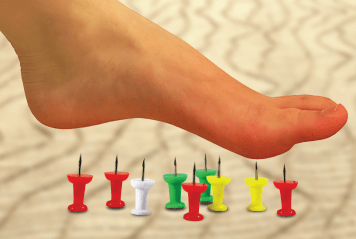
Diagnosed with Cancer? Your two greatest challenges are understanding cancer and understanding possible side effects from chemo and radiation. Knowledge is Power!
Learn about conventional, complementary, and integrative therapies.
Dealing with treatment side effects? Learn about evidence-based therapies to alleviate your symptoms.
Click the orange button to the right to learn more.
- You are here:
- Home »
- Blog »
- side effects ID and prevention »
- Neuropathic Pain Therapy-
Neuropathic Pain Therapy-

I am listing neuropathic pain therapies that are non-conventional below because there are few, if any, effective conventional neuropathic pain therapies.
I am a long-term survivor of cancer. CIPN is one of the most difficult side effects there is in my experience.
Which brings me to the reason for writing this post. According to research, more than 70% of myeloma patients struggle with chemotherapy-induced peripheral neuropathy (CIPN), yet few effective therapies exist. So when I come across studies like the one linked and excerpted below, that talk about effective CIPN therapies, I write about them.
I am including the list of non-conventional CIPN therapies in case there is one or more therapies that you don’t know about.
What are non-conventional neuropathic pain therapies ?
Neuropathic pain is a type of chronic pain that results from damage or dysfunction of the nervous system. While conventional treatments such as medications (antidepressants, anticonvulsants), physical therapy, and nerve blocks are commonly used, there are also some non-conventional therapies that some individuals find beneficial. It’s important to note that the effectiveness of these approaches can vary from person to person, and it’s advisable to consult with a healthcare professional before trying any new treatments. Here are some non-conventional therapies for neuropathic pain:
- Acupuncture: This traditional Chinese medicine involves inserting thin needles into specific points on the body to balance energy flow. Some studies suggest that acupuncture may help alleviate neuropathic pain by modulating the perception of pain.
- Biofeedback: This technique involves using electronic monitoring to help individuals gain awareness and control over physiological processes such as heart rate, muscle tension, and skin temperature. Biofeedback may assist in managing neuropathic pain by teaching individuals to control their response to pain.
- Transcutaneous Electrical Nerve Stimulation (TENS): TENS involves the use of a small, battery-operated device that delivers low-voltage electrical currents to the skin via electrodes. It is thought to interfere with the transmission of pain signals and may provide relief for some people with neuropathic pain.
- Mindfulness Meditation: Mindfulness practices, including meditation and deep-breathing exercises, can help individuals develop better control over their thoughts and reactions to pain. Mindfulness-based stress reduction (MBSR) programs may be particularly helpful.
- Cognitive Behavioral Therapy (CBT): CBT is a psychotherapeutic approach that helps individuals identify and change negative thought patterns and behaviors. It can be effective in managing the emotional and psychological aspects of chronic pain.
- Nutritional Supplements: Some individuals find relief from neuropathic pain by incorporating certain nutritional supplements into their diet. These may include alpha-lipoic acid, acetyl-L-carnitine, and omega-3 fatty acids. However, it’s essential to consult with a healthcare professional before starting any supplement regimen.
- Hypnotherapy: Hypnosis involves guided relaxation and focused attention to help individuals enter a trance-like state. Some studies suggest that hypnotherapy may be beneficial in managing chronic pain, including neuropathic pain.
- Physical Exercise and Rehabilitation: Engaging in regular, low-impact exercises such as swimming, tai chi, or yoga may help improve overall well-being and reduce neuropathic pain symptoms. Physical therapy can also be tailored to address specific issues related to nerve damage.
Are you a cancer survivor who struggles with nerve pain? If you would like to learn more about anti-cancer nutritional supplementation send me an email- David.PeopleBeatingCancer@gmail.com
Hang in there,
David Emerson
- Cancer Survivor
- Cancer Coach
- Director PeopleBeatingCancer
Researchers Uncover Potential Non-Opioid Treatment for Chronic Pain
“Among the most difficult types of pain to alleviate is neuropathic pain, pain that is usually caused by damage to nerves in various body tissues, including skin, muscle and joints. It can cause patients to suffer feelings like electric shocks, tingling, burning or stabbing. Diabetes, multiple sclerosis, chemotherapy drugs, injuries and amputations have all been associated with neuropathic pain, which is often chronic, sometimes unrelenting and affects millions of people worldwide. Many of the available pain medications are only moderately effective at treating this type of pain and often come with serious side effects, as well as risk of addiction…
“We found it to be an effective painkiller, and the effects were rather long-lived,” said Stephen Martin, the June and J. Virgil Waggoner Regents Chair in Chemistry at The University of Texas at Austin and co-corresponding author of the paper. “When we tested it on different models, diabetic neuropathy and chemotherapy-induced neuropathy, for example, we found this compound has an incredible beneficial effect…”
The new compound, dubbed FEM-1689, does not engage opioid receptors in the body, making it a possible alternative to existing pain medications linked to addiction. In addition to reducing sensitivity, the compound can help regulate the integrated stress response (ISR), a network of cellular signaling that helps the body respond to injuries and diseases. When well regulated, the ISR restores balance and promotes healing. When it goes awry, the ISR can contribute to diseases such as cancer, diabetes and metabolic disorders…”
Highly specific σ2R/TMEM97 ligand FEM-1689 alleviates neuropathic pain and inhibits the integrated stress response
“Significance- Neuropathic pain is a major medical problem that is poorly treated with existing therapeutics. Our findings demonstrate that targeting σ2R/TMEM97 with a modulator reduces pain hypersensitivity in a mouse model with exquisite selectivity.
We also identify integrated stress response (ISR) inhibition as a potential mechanism of action that links the receptor to cellular signaling events that have preclinical and clinical validation for pain relief. Our work suggests that σ2R/TMEM97 can be selectively engaged by specific small molecules to produce ISR inhibition in a subset of cells that are critical for neuropathic pain. σ2R/TMEM97-targeted therapeutics thus have the potential to offer effective pain relief without engagement of opioid receptors…
We and others have shown that σ2R/TMEM97 ligands alleviate mechanical hypersensitivity in mouse neuropathic pain models with a time course wherein maximal antinociceptive effect is approximately 24 h following dosing. We sought to understand this unique antineuropathic pain effect by addressing two key questions:
- do these σ2R/TMEM97 compounds act selectively via the receptor, and
- what is their downstream mechanism on nociceptive neurons?
These results validate σ2R/TMEM97 as a promising target for further development for the treatment of neuropathic pain…
Management of neuropathic pain is a major clinical challenge because available drugs not only have limited efficacy, but they also elicit serious side effects…


